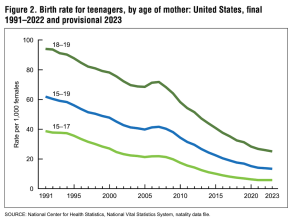Low birth rate and young people's sexual rights: Difference between revisions
The Admins (talk | contribs) No edit summary |
The Admins (talk | contribs) No edit summary |
||
| Line 3: | Line 3: | ||
It has been suggested that one way of increasing birth/fertility rate is to relax laws against [[statutory rape]] and allow some degree of [[Youth-Adult Marriage]], reintroducing pre- and postwar dating norms and normalizing [[Research: Teen pregnancy|teen pregnancies]]. More permissive norms with respect to the [[Transgender youth and attraction to minors|agency]] and [[Research: Cognitive ability|capacities]] of youth might also be pursued to combat [[ageism]], providing the basis for a broad cultural coalition between those concerned with the slow decline of western societies, and those more alarmed by potential back-slippage towards regressive social values. | It has been suggested that one way of increasing birth/fertility rate is to relax laws against [[statutory rape]] and allow some degree of [[Youth-Adult Marriage]], reintroducing pre- and postwar dating norms and normalizing [[Research: Teen pregnancy|teen pregnancies]]. More permissive norms with respect to the [[Transgender youth and attraction to minors|agency]] and [[Research: Cognitive ability|capacities]] of youth might also be pursued to combat [[ageism]], providing the basis for a broad cultural coalition between those concerned with the slow decline of western societies, and those more alarmed by potential back-slippage towards regressive social values. | ||
==Initiatives== | |||
In 2024, Russia made it's first moves towards banning the ideology of antinatalism:<ref>[https://nordictimes.com/world/russia-wants-to-ban-extremist-childlessness-ideology/ Russia wants to ban “extremist childlessness ideology” - Nordic Times]</ref> | |||
<blockquote> | |||
''We are now actively preparing bills to prevent the spread of child-free ideology. One should not be able to promote ideas that “nowadays girls, especially young ones, do not need to give birth, they can do without children”'' | |||
</blockquote> | |||
==External links== | ==External links== | ||
Revision as of 14:50, 4 July 2024

Total fertility rate (the average number of children birthed by a woman) is estimated to be at around the global replacement rate of 2.0-2.4 in the 2020s. Where fertility rate falls below replacement rate, global population starts to go into decline, negatively impacting economic performance and increasing the relative number of elderly and infirm people in developed societies.
It has been suggested that one way of increasing birth/fertility rate is to relax laws against statutory rape and allow some degree of Youth-Adult Marriage, reintroducing pre- and postwar dating norms and normalizing teen pregnancies. More permissive norms with respect to the agency and capacities of youth might also be pursued to combat ageism, providing the basis for a broad cultural coalition between those concerned with the slow decline of western societies, and those more alarmed by potential back-slippage towards regressive social values.
Initiatives
In 2024, Russia made it's first moves towards banning the ideology of antinatalism:[1]
We are now actively preparing bills to prevent the spread of child-free ideology. One should not be able to promote ideas that “nowadays girls, especially young ones, do not need to give birth, they can do without children”